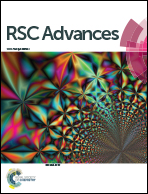Structure and photoluminescence characteristics of europium(iii) doped in CaAl2Si2O8 phosphors
Abstract
A series of Eu3+ activated CaAl2Si2O8 phosphors have been synthesized at 1350 °C in air, and their photoluminescence properties have been investigated as a function of activator concentrations. The results show that the dominant emission peak of the phosphors Ca1−3x/2Al2Si2O8:xEu3+ is located at ∼611 nm due to Eu3+ transition (5D0 → 7F2). The reduction reaction from Eu3+ to Eu2+ is observed by the luminescent spectra because of the charge compensation mechanism and the special structure of the CaAl2Si2O8 host lattice even when synthesized in air. The energy transfer rate between the Eu3+ pairs is not very high as proved by the results of the decay lifetimes and the efficiency of Eu3+ 5D0 → 7F2 emissions. The thermal quenching behaviour is attributed to the crossover process from the 5D0 to the charge transfer state (Eu3+–O2−) band. The CIE chromaticity coordinates of the red emission of the Ca0.925Eu0.05Al2Si2O8 phosphor is (0.59, 0.28), which is the NTSC system standard for red chromaticity. With enhanced properties (i.e., colour render property) and the ability to be efficiently stimulated by NUV and blue UV LEDs, this kind of phosphor can be used in developing novel types of flat panel and projection displays.


 Please wait while we load your content...
Please wait while we load your content...